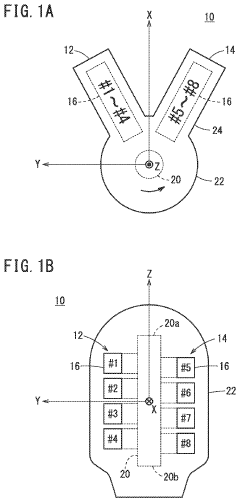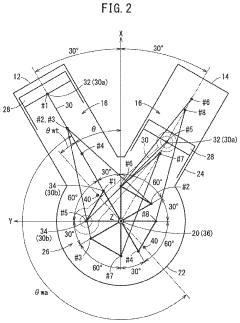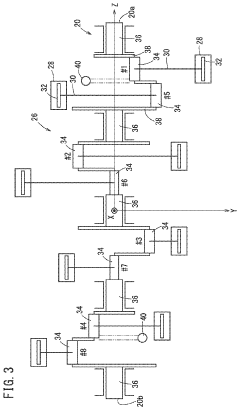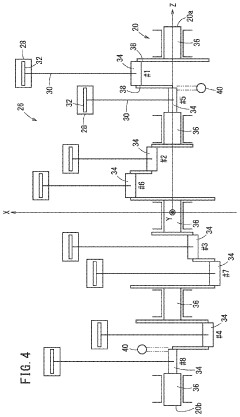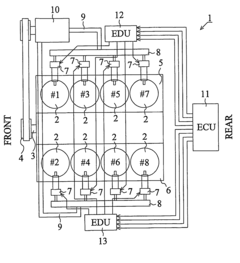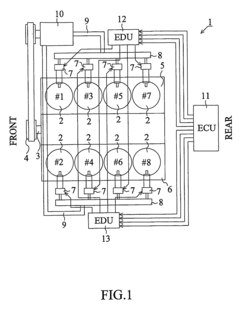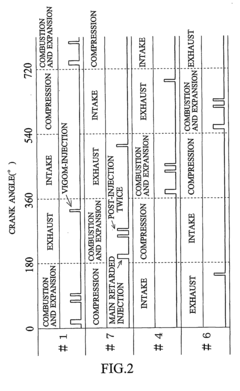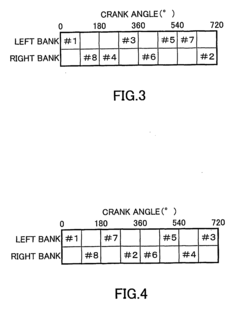Exploring V8 Engine Potential in Automated Driving
JUL 4, 20259 MIN READ
Generate Your Research Report Instantly with AI Agent
Patsnap Eureka helps you evaluate technical feasibility & market potential.
V8 Engine Evolution and Automated Driving Goals
The V8 engine has undergone significant evolution since its inception in the early 20th century. Initially designed for high-performance automobiles, V8 engines have become synonymous with power and efficiency in the automotive industry. Over the decades, advancements in materials science, fuel injection systems, and electronic control units have dramatically improved V8 engine performance, fuel efficiency, and emissions.
In recent years, the focus on V8 engine development has shifted towards integration with hybrid and electric powertrains, as well as compatibility with alternative fuels. This evolution aligns with the growing emphasis on sustainability and environmental concerns in the automotive sector. Manufacturers have been exploring ways to maintain the V8's characteristic power output while reducing its carbon footprint, leading to innovations such as cylinder deactivation and start-stop systems.
The intersection of V8 engine technology and automated driving presents a unique set of challenges and opportunities. As the automotive industry moves towards higher levels of automation, the role of the engine in vehicle control becomes increasingly critical. The goal is to seamlessly integrate the V8 engine's capabilities with the complex systems required for autonomous operation.
One key objective is to optimize the V8 engine's performance for the specific demands of automated driving scenarios. This includes developing more precise control over power delivery, improving responsiveness to sudden changes in driving conditions, and enhancing overall efficiency to extend the range of autonomous vehicles. Additionally, there is a focus on refining the engine's noise, vibration, and harshness (NVH) characteristics to ensure passenger comfort in self-driving cars.
Another important goal is to enhance the V8 engine's compatibility with the advanced sensor systems and computing platforms required for automated driving. This involves developing sophisticated engine management systems that can communicate effectively with autonomous driving software, allowing for real-time adjustments based on road conditions, traffic patterns, and vehicle dynamics.
Furthermore, researchers are exploring ways to leverage the V8 engine's power generation capabilities to support the energy-intensive components of automated driving systems, such as LiDAR sensors, radar arrays, and onboard computers. This could potentially involve integrating advanced alternators or developing novel energy recovery systems to maximize the engine's efficiency in powering both the vehicle and its autonomous features.
As the automotive industry continues to push towards higher levels of automation, the evolution of V8 engine technology will play a crucial role in shaping the future of transportation. The goals of this technological convergence are to create safer, more efficient, and more capable vehicles that can operate autonomously while still delivering the performance and driving experience that V8 engines are known for.
In recent years, the focus on V8 engine development has shifted towards integration with hybrid and electric powertrains, as well as compatibility with alternative fuels. This evolution aligns with the growing emphasis on sustainability and environmental concerns in the automotive sector. Manufacturers have been exploring ways to maintain the V8's characteristic power output while reducing its carbon footprint, leading to innovations such as cylinder deactivation and start-stop systems.
The intersection of V8 engine technology and automated driving presents a unique set of challenges and opportunities. As the automotive industry moves towards higher levels of automation, the role of the engine in vehicle control becomes increasingly critical. The goal is to seamlessly integrate the V8 engine's capabilities with the complex systems required for autonomous operation.
One key objective is to optimize the V8 engine's performance for the specific demands of automated driving scenarios. This includes developing more precise control over power delivery, improving responsiveness to sudden changes in driving conditions, and enhancing overall efficiency to extend the range of autonomous vehicles. Additionally, there is a focus on refining the engine's noise, vibration, and harshness (NVH) characteristics to ensure passenger comfort in self-driving cars.
Another important goal is to enhance the V8 engine's compatibility with the advanced sensor systems and computing platforms required for automated driving. This involves developing sophisticated engine management systems that can communicate effectively with autonomous driving software, allowing for real-time adjustments based on road conditions, traffic patterns, and vehicle dynamics.
Furthermore, researchers are exploring ways to leverage the V8 engine's power generation capabilities to support the energy-intensive components of automated driving systems, such as LiDAR sensors, radar arrays, and onboard computers. This could potentially involve integrating advanced alternators or developing novel energy recovery systems to maximize the engine's efficiency in powering both the vehicle and its autonomous features.
As the automotive industry continues to push towards higher levels of automation, the evolution of V8 engine technology will play a crucial role in shaping the future of transportation. The goals of this technological convergence are to create safer, more efficient, and more capable vehicles that can operate autonomously while still delivering the performance and driving experience that V8 engines are known for.
Market Demand for V8-Powered Autonomous Vehicles
The market demand for V8-powered autonomous vehicles represents a niche yet potentially lucrative segment within the broader autonomous driving industry. While the traditional V8 engine is often associated with high-performance vehicles and luxury cars, its application in autonomous driving scenarios presents both opportunities and challenges.
In the luxury and high-end vehicle market, there is a growing interest in combining the power and prestige of V8 engines with advanced autonomous driving capabilities. This demand is primarily driven by affluent consumers who desire vehicles that offer both cutting-edge technology and the classic appeal of V8 performance. Luxury automakers are exploring ways to integrate V8 engines into their autonomous vehicle lineups to cater to this specific market segment.
The commercial transportation sector also shows potential for V8-powered autonomous vehicles, particularly in long-haul trucking and heavy-duty applications. The robust power output and reliability of V8 engines make them suitable for autonomous trucks that need to cover long distances while carrying heavy loads. This market segment values the combination of autonomy for improved safety and efficiency, along with the proven performance of V8 engines.
However, the demand for V8-powered autonomous vehicles faces several challenges. Environmental concerns and stricter emissions regulations are pushing the automotive industry towards more fuel-efficient and environmentally friendly powertrains. This trend may limit the growth potential of V8 engines in autonomous vehicles, especially in regions with stringent environmental policies.
The sports and performance car market presents another avenue for V8-powered autonomous vehicles. Enthusiasts and collectors who appreciate the sound and power of V8 engines may be interested in vehicles that can switch between autonomous operation and manual driving modes. This dual-mode capability could create a unique selling point for manufacturers targeting this niche market.
In terms of market size, while specific figures for V8-powered autonomous vehicles are not readily available, the overall autonomous vehicle market is projected to grow significantly in the coming years. The integration of V8 engines into this growing market will likely remain a specialized segment, catering to specific consumer preferences and applications.
The demand for V8-powered autonomous vehicles is also influenced by regional factors. In markets where V8 engines have a strong cultural significance, such as the United States, there may be a higher acceptance and demand for these vehicles. Conversely, in regions prioritizing electric and hybrid powertrains, the market for V8-powered autonomous vehicles may be more limited.
As the autonomous driving technology continues to evolve, the market demand for V8-powered vehicles in this space will likely be shaped by advancements in engine efficiency, changing consumer preferences, and the ability of manufacturers to successfully marry traditional V8 performance with cutting-edge autonomous capabilities.
In the luxury and high-end vehicle market, there is a growing interest in combining the power and prestige of V8 engines with advanced autonomous driving capabilities. This demand is primarily driven by affluent consumers who desire vehicles that offer both cutting-edge technology and the classic appeal of V8 performance. Luxury automakers are exploring ways to integrate V8 engines into their autonomous vehicle lineups to cater to this specific market segment.
The commercial transportation sector also shows potential for V8-powered autonomous vehicles, particularly in long-haul trucking and heavy-duty applications. The robust power output and reliability of V8 engines make them suitable for autonomous trucks that need to cover long distances while carrying heavy loads. This market segment values the combination of autonomy for improved safety and efficiency, along with the proven performance of V8 engines.
However, the demand for V8-powered autonomous vehicles faces several challenges. Environmental concerns and stricter emissions regulations are pushing the automotive industry towards more fuel-efficient and environmentally friendly powertrains. This trend may limit the growth potential of V8 engines in autonomous vehicles, especially in regions with stringent environmental policies.
The sports and performance car market presents another avenue for V8-powered autonomous vehicles. Enthusiasts and collectors who appreciate the sound and power of V8 engines may be interested in vehicles that can switch between autonomous operation and manual driving modes. This dual-mode capability could create a unique selling point for manufacturers targeting this niche market.
In terms of market size, while specific figures for V8-powered autonomous vehicles are not readily available, the overall autonomous vehicle market is projected to grow significantly in the coming years. The integration of V8 engines into this growing market will likely remain a specialized segment, catering to specific consumer preferences and applications.
The demand for V8-powered autonomous vehicles is also influenced by regional factors. In markets where V8 engines have a strong cultural significance, such as the United States, there may be a higher acceptance and demand for these vehicles. Conversely, in regions prioritizing electric and hybrid powertrains, the market for V8-powered autonomous vehicles may be more limited.
As the autonomous driving technology continues to evolve, the market demand for V8-powered vehicles in this space will likely be shaped by advancements in engine efficiency, changing consumer preferences, and the ability of manufacturers to successfully marry traditional V8 performance with cutting-edge autonomous capabilities.
V8 Engine Challenges in Automated Driving Systems
The integration of V8 engines into automated driving systems presents several significant challenges that require innovative solutions. One of the primary obstacles is the need for precise control over engine performance to ensure smooth and safe autonomous operation. Traditional V8 engines, designed for manual or semi-automatic control, lack the fine-tuned responsiveness necessary for the split-second decisions made by autonomous driving systems.
Another major challenge lies in the optimization of fuel efficiency and emissions reduction while maintaining the power output expected from V8 engines. Automated driving systems demand consistent performance across various driving conditions, which can be difficult to achieve with conventional V8 engine designs. The need for rapid acceleration and deceleration, coupled with long periods of steady-state operation, creates a complex set of requirements for engine management systems.
The integration of advanced sensors and control systems into V8 engines poses another significant hurdle. These systems must be capable of real-time monitoring and adjustment of engine parameters to align with the decisions made by the autonomous driving software. This requires a level of engine control granularity that exceeds what is typically found in consumer vehicles.
Thermal management presents an additional challenge, particularly in stop-and-go traffic scenarios common in urban environments. V8 engines generate substantial heat, which can affect the performance of sensitive electronic components crucial for automated driving systems. Developing effective cooling solutions that do not compromise the vehicle's aerodynamics or add significant weight is a complex engineering task.
Noise, vibration, and harshness (NVH) characteristics of V8 engines also need to be addressed. Automated driving systems rely on a multitude of sensors, some of which can be affected by engine-induced vibrations. Minimizing these disturbances without sacrificing the engine's performance or the iconic V8 sound is a delicate balancing act.
Lastly, the challenge of seamlessly integrating the V8 engine with electric powertrains in hybrid configurations adds another layer of complexity. Many automated driving systems are being developed with electrification in mind, requiring V8 engines to work in harmony with electric motors and battery systems. This integration must be achieved without compromising the responsiveness and reliability expected in autonomous vehicles.
Addressing these challenges requires a multidisciplinary approach, combining expertise in mechanical engineering, electronic control systems, and software development. As the automotive industry continues to evolve towards autonomous vehicles, overcoming these hurdles will be crucial in determining the role of V8 engines in the future of automated driving.
Another major challenge lies in the optimization of fuel efficiency and emissions reduction while maintaining the power output expected from V8 engines. Automated driving systems demand consistent performance across various driving conditions, which can be difficult to achieve with conventional V8 engine designs. The need for rapid acceleration and deceleration, coupled with long periods of steady-state operation, creates a complex set of requirements for engine management systems.
The integration of advanced sensors and control systems into V8 engines poses another significant hurdle. These systems must be capable of real-time monitoring and adjustment of engine parameters to align with the decisions made by the autonomous driving software. This requires a level of engine control granularity that exceeds what is typically found in consumer vehicles.
Thermal management presents an additional challenge, particularly in stop-and-go traffic scenarios common in urban environments. V8 engines generate substantial heat, which can affect the performance of sensitive electronic components crucial for automated driving systems. Developing effective cooling solutions that do not compromise the vehicle's aerodynamics or add significant weight is a complex engineering task.
Noise, vibration, and harshness (NVH) characteristics of V8 engines also need to be addressed. Automated driving systems rely on a multitude of sensors, some of which can be affected by engine-induced vibrations. Minimizing these disturbances without sacrificing the engine's performance or the iconic V8 sound is a delicate balancing act.
Lastly, the challenge of seamlessly integrating the V8 engine with electric powertrains in hybrid configurations adds another layer of complexity. Many automated driving systems are being developed with electrification in mind, requiring V8 engines to work in harmony with electric motors and battery systems. This integration must be achieved without compromising the responsiveness and reliability expected in autonomous vehicles.
Addressing these challenges requires a multidisciplinary approach, combining expertise in mechanical engineering, electronic control systems, and software development. As the automotive industry continues to evolve towards autonomous vehicles, overcoming these hurdles will be crucial in determining the role of V8 engines in the future of automated driving.
Current V8 Integration Solutions for Autonomous Vehicles
01 V8 Engine Design and Configuration
V8 engines are designed with eight cylinders arranged in two banks of four, forming a V-shape. This configuration allows for a compact design, improved balance, and higher power output compared to inline engines. Various aspects of V8 engine design, including cylinder arrangement, crankshaft configuration, and valve train systems, are continuously improved to enhance performance and efficiency.- V8 Engine Design and Configuration: V8 engines are designed with eight cylinders arranged in two banks of four, forming a V-shape. This configuration allows for a compact design while providing high power output. Various aspects of V8 engine design, including cylinder arrangement, crankshaft configuration, and valve timing, are continuously improved to enhance performance and efficiency.
- Fuel Efficiency and Emissions Control: Modern V8 engines incorporate advanced technologies to improve fuel efficiency and reduce emissions. These may include direct fuel injection, variable valve timing, cylinder deactivation, and advanced exhaust gas recirculation systems. Such innovations help V8 engines meet stringent environmental regulations while maintaining high performance.
- Turbocharging and Supercharging: Forced induction systems, such as turbochargers and superchargers, are often used in V8 engines to increase power output and efficiency. These systems compress the intake air, allowing more fuel to be burned and generating more power from the same engine displacement. Advanced control systems optimize boost pressure and fuel delivery for improved performance across various operating conditions.
- Cooling and Lubrication Systems: Effective cooling and lubrication are crucial for V8 engine performance and longevity. Advanced cooling systems may include precision-controlled electric water pumps, optimized coolant flow paths, and high-efficiency radiators. Lubrication systems are designed to ensure proper oil distribution to all critical components, even under high-performance conditions.
- Materials and Manufacturing Techniques: The use of advanced materials and manufacturing techniques plays a significant role in V8 engine development. Lightweight alloys, composite materials, and precision manufacturing processes are employed to reduce engine weight, improve thermal efficiency, and enhance durability. These advancements contribute to better power-to-weight ratios and overall engine performance.
02 Fuel Efficiency and Emissions Control
Modern V8 engines incorporate advanced technologies to improve fuel efficiency and reduce emissions. These may include direct fuel injection, variable valve timing, cylinder deactivation, and advanced exhaust gas recirculation systems. Such innovations help V8 engines meet stringent environmental regulations while maintaining high performance characteristics.Expand Specific Solutions03 Performance Enhancement Technologies
Various technologies are employed to enhance the performance of V8 engines. These may include turbocharging, supercharging, intercooling, and advanced engine management systems. Such technologies aim to increase power output, improve torque characteristics, and optimize overall engine performance across different operating conditions.Expand Specific Solutions04 Cooling and Lubrication Systems
Effective cooling and lubrication are crucial for V8 engine performance and longevity. Advanced cooling systems may incorporate precision coolant flow control, while lubrication systems may feature high-efficiency oil pumps and advanced filtration. These systems help manage engine temperatures, reduce friction, and extend engine life.Expand Specific Solutions05 Manufacturing and Assembly Techniques
Innovative manufacturing and assembly techniques are employed in V8 engine production to improve quality, reduce weight, and enhance durability. These may include advanced casting methods, precision machining techniques, and the use of lightweight materials. Assembly processes are often optimized for efficiency and consistency in production.Expand Specific Solutions
Key Players in V8 and Automated Driving Industries
The exploration of V8 engine potential in automated driving is at a nascent stage, with the market still in its early growth phase. The technology's maturity varies across companies, with established automakers like Toyota, Nissan, BMW, Ford, and Honda leading the way due to their extensive experience in engine development and autonomous technologies. Emerging players such as Hyundai and Cybernet Systems are also making significant strides. The market size is expected to expand rapidly as autonomous driving technology advances, with V8 engines potentially offering high performance and power for larger autonomous vehicles. However, the industry faces challenges in balancing power with efficiency and adapting V8 technology to meet the specific requirements of automated driving systems.
Toyota Motor Corp.
Technical Solution: Toyota has been investigating the integration of V8 engines with automated driving technologies, focusing on their Lexus brand. They have developed a system called "Teammate" which incorporates automated driving features with traditional V8 power[4]. The company has been working on optimizing the V8 engine's performance for autonomous operation, including fine-tuning throttle response and transmission shifting patterns to work seamlessly with autonomous driving algorithms. Toyota's approach includes the use of advanced machine learning techniques to continuously improve the interaction between the V8 engine and the automated driving system[5]. They have also been exploring the use of hybrid V8 powertrains to balance performance and efficiency in automated driving scenarios[6].
Strengths: Strong reputation for reliability and quality. Advanced hybrid technology integration. Weaknesses: Relatively late entry into full autonomous driving compared to some competitors.
Nissan Motor Co., Ltd.
Technical Solution: Nissan has been exploring the potential of V8 engines in automated driving through their ProPILOT system. While primarily focused on smaller engines, Nissan has been adapting their autonomous technologies to work with V8 engines in their high-end Infiniti models[7]. The company has developed advanced control algorithms that optimize the V8 engine's power delivery and fuel efficiency during autonomous operation. Nissan's approach includes the integration of their e-POWER series hybrid system with V8 engines to provide instant torque for automated driving maneuvers while maintaining fuel efficiency[8]. They have also been working on enhancing the V8 engine's responsiveness to work seamlessly with their autonomous emergency braking and adaptive cruise control systems[9].
Strengths: Innovative e-POWER hybrid technology. Strong focus on electric and autonomous technologies. Weaknesses: Less experience with V8 engines compared to some competitors.
Core Innovations in V8 Engine Automated Control
V8 engine
PatentActiveUS20230109196A1
Innovation
- The V8 engine configuration features crank pins arranged at 90° intervals on one bank and offset by 60° on the other bank, allowing for cancellation of primary inertia couples without additional specialized components by optimizing the arrangement of crank pins and connecting rods.
Eight-cylinder engine
PatentInactiveUS20070034177A1
Innovation
- The engine is configured with two valve drive units, where one drives fuel injection valves for cylinders with combustion and expansion strokes at equal intervals (1st, 3rd, 5th, and 7th cylinders) and the other for cylinders with equal intervals (2nd, 4th, 6th, and 8th cylinders), mimicking the energization sequence of a four-cylinder engine to maintain consistent energization intervals.
Environmental Impact of V8 Engines in Autonomous Vehicles
The environmental impact of V8 engines in autonomous vehicles is a complex issue that requires careful consideration. While V8 engines are known for their power and performance, their use in self-driving cars raises concerns about fuel efficiency and emissions. Autonomous vehicles are expected to operate more efficiently than human-driven cars, potentially offsetting some of the environmental drawbacks associated with V8 engines.
One of the primary environmental concerns is the increased fuel consumption of V8 engines compared to smaller, more efficient powertrains. This higher fuel consumption directly translates to increased carbon dioxide emissions, contributing to climate change. However, the integration of V8 engines in autonomous vehicles may lead to optimized driving patterns that could partially mitigate these effects. Advanced AI systems can potentially manage engine performance more efficiently than human drivers, reducing unnecessary acceleration and deceleration.
The production of V8 engines also has environmental implications. The manufacturing process requires more resources and energy compared to smaller engines, resulting in a larger carbon footprint before the vehicle even hits the road. This increased environmental cost at the production stage must be weighed against the potential long-term benefits of V8-powered autonomous vehicles.
Noise pollution is another factor to consider. V8 engines are typically louder than their smaller counterparts, which could have implications for urban environments where autonomous vehicles are expected to operate extensively. However, advancements in sound insulation and engine design may help mitigate this issue in future autonomous V8-powered vehicles.
On the positive side, the durability and longevity of V8 engines could potentially extend the lifespan of autonomous vehicles, reducing the need for frequent replacements and thereby decreasing the overall environmental impact of vehicle production. Additionally, the power output of V8 engines could be beneficial for larger autonomous vehicles designed for long-haul transportation, potentially improving efficiency in the logistics sector.
The environmental impact of V8 engines in autonomous vehicles also depends on the source of fuel. As the automotive industry shifts towards cleaner energy sources, the development of V8 engines that can run on alternative fuels or hybrid systems could significantly reduce their environmental footprint. This adaptation could allow for the retention of V8 performance characteristics while aligning with sustainability goals.
In conclusion, while V8 engines in autonomous vehicles present environmental challenges, particularly in terms of emissions and fuel consumption, their impact is not entirely negative. The potential for optimized performance through AI-driven systems, coupled with advancements in engine technology and alternative fuels, may help balance their environmental drawbacks with their performance benefits in the context of autonomous driving.
One of the primary environmental concerns is the increased fuel consumption of V8 engines compared to smaller, more efficient powertrains. This higher fuel consumption directly translates to increased carbon dioxide emissions, contributing to climate change. However, the integration of V8 engines in autonomous vehicles may lead to optimized driving patterns that could partially mitigate these effects. Advanced AI systems can potentially manage engine performance more efficiently than human drivers, reducing unnecessary acceleration and deceleration.
The production of V8 engines also has environmental implications. The manufacturing process requires more resources and energy compared to smaller engines, resulting in a larger carbon footprint before the vehicle even hits the road. This increased environmental cost at the production stage must be weighed against the potential long-term benefits of V8-powered autonomous vehicles.
Noise pollution is another factor to consider. V8 engines are typically louder than their smaller counterparts, which could have implications for urban environments where autonomous vehicles are expected to operate extensively. However, advancements in sound insulation and engine design may help mitigate this issue in future autonomous V8-powered vehicles.
On the positive side, the durability and longevity of V8 engines could potentially extend the lifespan of autonomous vehicles, reducing the need for frequent replacements and thereby decreasing the overall environmental impact of vehicle production. Additionally, the power output of V8 engines could be beneficial for larger autonomous vehicles designed for long-haul transportation, potentially improving efficiency in the logistics sector.
The environmental impact of V8 engines in autonomous vehicles also depends on the source of fuel. As the automotive industry shifts towards cleaner energy sources, the development of V8 engines that can run on alternative fuels or hybrid systems could significantly reduce their environmental footprint. This adaptation could allow for the retention of V8 performance characteristics while aligning with sustainability goals.
In conclusion, while V8 engines in autonomous vehicles present environmental challenges, particularly in terms of emissions and fuel consumption, their impact is not entirely negative. The potential for optimized performance through AI-driven systems, coupled with advancements in engine technology and alternative fuels, may help balance their environmental drawbacks with their performance benefits in the context of autonomous driving.
Safety Regulations for V8-Powered Self-Driving Cars
The development of V8-powered self-driving cars presents unique challenges in terms of safety regulations. As these high-performance vehicles integrate automated driving systems, regulatory bodies must adapt existing frameworks to address the specific risks associated with powerful engines and autonomous capabilities.
One of the primary concerns is the potential for excessive speed and acceleration. V8 engines are known for their high power output, which could lead to dangerous situations if not properly controlled by the autonomous system. Regulators are likely to impose strict limitations on the maximum speed and acceleration rates of V8-powered self-driving cars, particularly in urban environments and areas with high pedestrian traffic.
Another critical aspect of safety regulations will focus on the integration of advanced driver assistance systems (ADAS) with the V8 engine's performance characteristics. These systems must be capable of managing the engine's power output in various driving scenarios, ensuring smooth and safe operation. Regulations may require manufacturers to demonstrate robust fail-safe mechanisms that can quickly and effectively reduce engine power in the event of system malfunctions or unexpected situations.
Fuel efficiency and emissions standards will also play a significant role in shaping safety regulations for V8-powered self-driving cars. While V8 engines are traditionally associated with high fuel consumption and emissions, regulators may mandate the implementation of advanced engine management systems and hybrid technologies to mitigate these concerns. This could include requirements for intelligent cylinder deactivation, start-stop systems, and regenerative braking to optimize fuel efficiency and reduce environmental impact.
The noise generated by V8 engines is another area that safety regulations will need to address. In urban environments, excessive noise can be a safety hazard, potentially masking important auditory cues for pedestrians and other road users. Regulators may impose strict noise limits on V8-powered self-driving cars, necessitating the development of advanced exhaust systems and sound-dampening technologies.
Safety regulations will also likely require enhanced testing and validation procedures for V8-powered self-driving cars. This may include extensive real-world testing in various driving conditions, as well as comprehensive simulation scenarios that specifically address the unique challenges posed by high-performance engines in autonomous vehicles. Manufacturers may be required to demonstrate the ability of their autonomous systems to handle the increased power and torque of V8 engines safely and effectively.
Furthermore, regulations may mandate the implementation of specialized driver monitoring systems for V8-powered self-driving cars. These systems would be designed to ensure that human drivers remain alert and ready to take control of the vehicle when necessary, particularly in situations where the autonomous system may struggle to manage the engine's power output safely.
One of the primary concerns is the potential for excessive speed and acceleration. V8 engines are known for their high power output, which could lead to dangerous situations if not properly controlled by the autonomous system. Regulators are likely to impose strict limitations on the maximum speed and acceleration rates of V8-powered self-driving cars, particularly in urban environments and areas with high pedestrian traffic.
Another critical aspect of safety regulations will focus on the integration of advanced driver assistance systems (ADAS) with the V8 engine's performance characteristics. These systems must be capable of managing the engine's power output in various driving scenarios, ensuring smooth and safe operation. Regulations may require manufacturers to demonstrate robust fail-safe mechanisms that can quickly and effectively reduce engine power in the event of system malfunctions or unexpected situations.
Fuel efficiency and emissions standards will also play a significant role in shaping safety regulations for V8-powered self-driving cars. While V8 engines are traditionally associated with high fuel consumption and emissions, regulators may mandate the implementation of advanced engine management systems and hybrid technologies to mitigate these concerns. This could include requirements for intelligent cylinder deactivation, start-stop systems, and regenerative braking to optimize fuel efficiency and reduce environmental impact.
The noise generated by V8 engines is another area that safety regulations will need to address. In urban environments, excessive noise can be a safety hazard, potentially masking important auditory cues for pedestrians and other road users. Regulators may impose strict noise limits on V8-powered self-driving cars, necessitating the development of advanced exhaust systems and sound-dampening technologies.
Safety regulations will also likely require enhanced testing and validation procedures for V8-powered self-driving cars. This may include extensive real-world testing in various driving conditions, as well as comprehensive simulation scenarios that specifically address the unique challenges posed by high-performance engines in autonomous vehicles. Manufacturers may be required to demonstrate the ability of their autonomous systems to handle the increased power and torque of V8 engines safely and effectively.
Furthermore, regulations may mandate the implementation of specialized driver monitoring systems for V8-powered self-driving cars. These systems would be designed to ensure that human drivers remain alert and ready to take control of the vehicle when necessary, particularly in situations where the autonomous system may struggle to manage the engine's power output safely.
Unlock deeper insights with Patsnap Eureka Quick Research — get a full tech report to explore trends and direct your research. Try now!
Generate Your Research Report Instantly with AI Agent
Supercharge your innovation with Patsnap Eureka AI Agent Platform!
